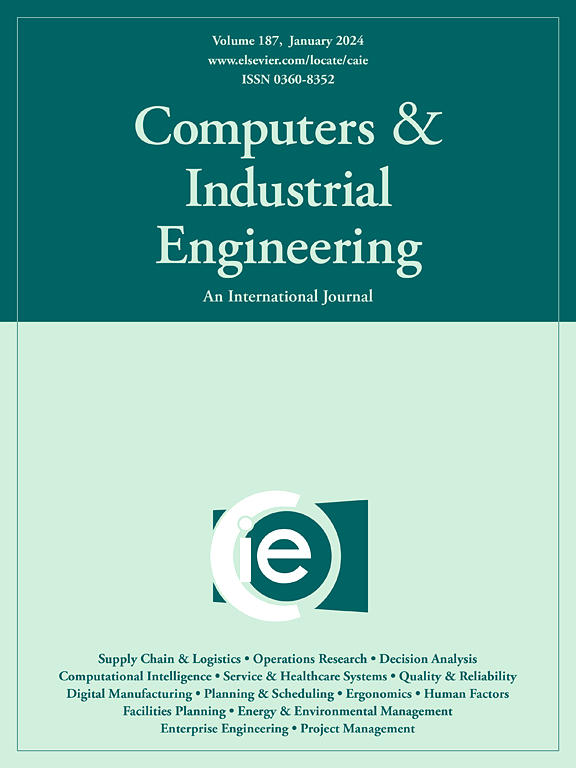在不确定的情况下协调肿瘤医生预约化疗
IF 6.7
1区 工程技术
Q1 COMPUTER SCIENCE, INTERDISCIPLINARY APPLICATIONS
引用次数: 0
摘要
由于资源有限、输注时间的不确定性以及需要与肿瘤学家协商,门诊化疗诊所(OCCs)的化疗计划面临着重大挑战。本研究通过整合肿瘤学家咨询和化疗计划,通过确定每日患者名单的预约时间来解决这些挑战。考虑输液时间和会诊后化疗批准情况等随机因素,建立了两阶段随机混合整数规划模型。在模型的第一阶段,将每个肿瘤医生的患者按顺序组织,并设置预约时间。在第二阶段,患者被分配到椅子和护士使用最佳的近视政策。目标函数对OCC总工作时间和患者等待时间的期望加权和进行惩罚。为了用简化后的场景集来表示原始场景集,采用了场景约简算法。该算法是一种基于Wasserstein距离的局部搜索算法(WD-LSA),使用土耳其一家主要学术肿瘤医院的真实数据进行了测试。通过与CPLEX算法在少量场景和启发式算法在大量场景下的性能比较,证明了WD-LSA算法的性能。我们发现,与CPLEX解相比,该方法的解差距很小,而且比文献中实际调度启发式方法的解要好得多。评估患者等待时间和总工作时间之间的权衡。研究了绩效指标对肿瘤学家和护士数量的依赖性。最后,对随机解的值进行了估计。本文章由计算机程序翻译,如有差异,请以英文原文为准。
Coordinating oncologist appointments with chemotherapy treatments under uncertainty
Scheduling chemotherapy treatments in outpatient chemotherapy clinics (OCCs) presents significant challenges due to limited resources, uncertainty in infusion durations, and the need for coordinating with oncologist consultations. This study addresses these challenges through integrating oncologist consultation and chemotherapy scheduling by determining appointment times for a daily list of patients. A two-stage stochastic mixed-integer programming model is developed, considering stochastic factors such as infusion durations and the statuses of chemotherapy treatment approvals after consultations. In the first stage of the model, patients of each oncologist are organized in a sequence, and appointment times are set. In the second stage, patients are assigned to chairs and nurses using an optimal myopic policy. The objective function penalizes the expected weighted sum of the total working time of the OCC and the waiting times of patients. To represent the original scenario set by a reduced scenario set, a scenario reduction algorithm is employed. The algorithm, a Wasserstein Distance-Based Local Search Algorithm (WD-LSA), is tested using real data from a major academic oncology hospital in Turkey. The performance of the WD-LSA algorithm is demonstrated by comparing with CPLEX for smaller number of scenarios and with heuristic algorithms for larger number of scenarios. We find that the gap is quite small when compared with CPLEX solutions and the solutions are much better than the solutions found by the practical scheduling heuristics from the literature. The trade-off between patient waiting time and total working time is assessed. The dependency of the performance measures to the number of oncologists and nurses is investigated. Lastly, the value of stochastic solution is estimated.
求助全文
通过发布文献求助,成功后即可免费获取论文全文。
去求助
来源期刊

Computers & Industrial Engineering
工程技术-工程:工业
CiteScore
12.70
自引率
12.70%
发文量
794
审稿时长
10.6 months
期刊介绍:
Computers & Industrial Engineering (CAIE) is dedicated to researchers, educators, and practitioners in industrial engineering and related fields. Pioneering the integration of computers in research, education, and practice, industrial engineering has evolved to make computers and electronic communication integral to its domain. CAIE publishes original contributions focusing on the development of novel computerized methodologies to address industrial engineering problems. It also highlights the applications of these methodologies to issues within the broader industrial engineering and associated communities. The journal actively encourages submissions that push the boundaries of fundamental theories and concepts in industrial engineering techniques.
 求助内容:
求助内容: 应助结果提醒方式:
应助结果提醒方式:


